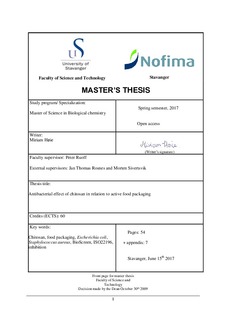| dc.description.abstract | Food safety has a high priority in the food industry. In order to be able to give the consumers safe products, the producers continuously work with methods to inhibit growth of bacteria in the foods during storage. Recently, the industry has paid attention to the use of active packaging methods that contain antimicrobial substances. Among these, chitosan has been widely investigated. In this study, potential packaging materials containing chitosan was tested against the Gram-positive bacterium Staphylococcus aureus (S. aureus) and the Gram-negative bacterium Escherichia coli (E. coli). One of the packaging materials was used to make trays in which smoked salmon was packaged, and the fish was tested during storage to see if there was a detectable effect of the active packaging material.
The method ISO 22196:2007 was used to compare the antibacterial effect of different chitosan-containing films when they were tested against the same volume of bacteria, with a known contact area between the bacteria solution and the active film. This method had a lot of elements affecting the results, and also many uncertainties. The method was unstable, giving results that were invalid according to the standard. However, there seemed to be some antibacterial effect from the chitosan-containing films. The film containing MB as plasticizer, 8% polyethylene glycol and 2% modified chitosan with nanoclay C30B caused the largest log reduction of E. coli, log 3.67. Against S. aureus the films containing MB as plasticizer, polyethylene glycol and 1% rosehip-modified chitosan gave best results, with a log reduction of 4.48.
In order to gain more reliable results, a method was used where chitosan was tested in a liquid bacteria solution. In this method, different amounts of chitosan film containing 5% chitosan and chitosan powder was added to the bacteria solution and incubated at different temperatures with regular sampling during incubation. The best effect of the chitosan film was seen when the samples had an initial bacterial concentration about log 5 cfu/ml with incubation at 10°C. Here, a clear effect was found against both of the tested bacteria; E. coli decreased below the detection limit after five days and S. aureus after six days for the samples containing most of the chitosan film. The results from incubation with chitosan powder were similar to those from testing of the film, but the bacterial counts decreased below the detection limit earlier in the incubation. E. coli counts were below the detection limit after four days, and S. aureus counts after three days for the samples with most chitosan, when having a start concentration of bacteria about log 5 cfu/ml with incubation at 10°C. These results strengthens the theory that chitosan is less available inside a rigid film structure than it is in the form of chitosan powder.
As the results from the liquid tests were promising, chitosan colloid was tested by comparison of growth curves with and without chitosan. The chitosan powder was solved in acetic acid, and this solution was then tested against the aforementioned bacteria by reading absorbance in bacteria solutions during incubation. The data was used to make growth curves, which made it possible to compare the bacterial growth between samples with and without chitosan. The acid tolerance of the bacteria became very limiting for the experiments, but at acid concentrations of 0.1% and 0.5% it was possible to detect an effect of the chitosan compared to the control samples. However, the effect might not be caused by the chitosan alone, but rather of a combination of chitosan together with the lowered pH.
The reason of testing the chitosan films and powder was to see if chitosan-containing packaging materials could be used on foods to enhance food safety. Because some of the test methods gave good results, an experiment was conducted on smoked salmon. The salmon was packaged in 100% N2 (g) in a tray containing 1% chitosan. This was a storage experiment, and sampling was performed during storage for 41 days. Compared to the control sample, packaged in a HDPE tray, the salmon packaged in chitosan trays had the same bacterial numbers in the beginning of the experiment, but towards the end the bacterial numbers in the sample packaged in PLA-chitosan tray increased to log 7 cfu/g, while the control sample ended at a bacterial number of log 5 cfu/g. This shows that the bacteria in the fish samples grew despite the presence of chitosan, which can be caused by the chitosan not being available for the bacteria, but it can also be that the trays should have had a higher chitosan concentration. | nb_NO |

